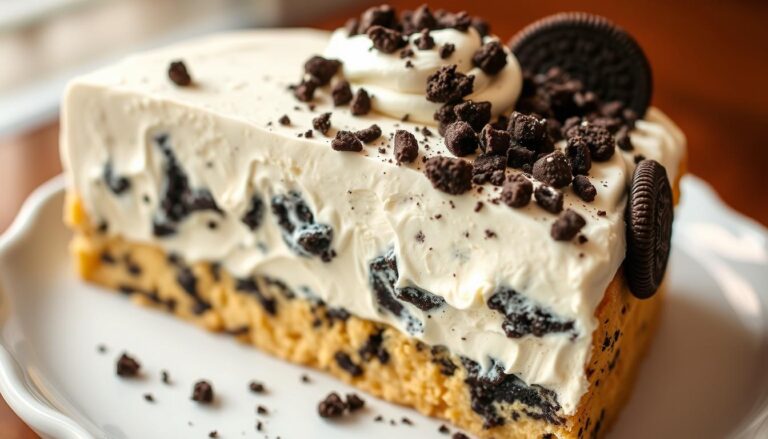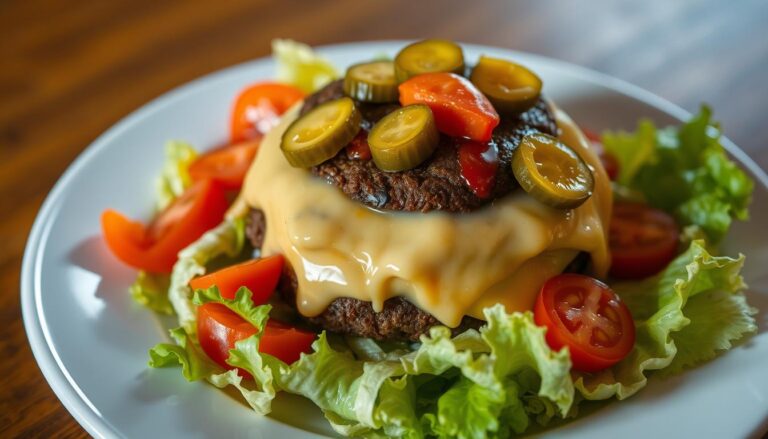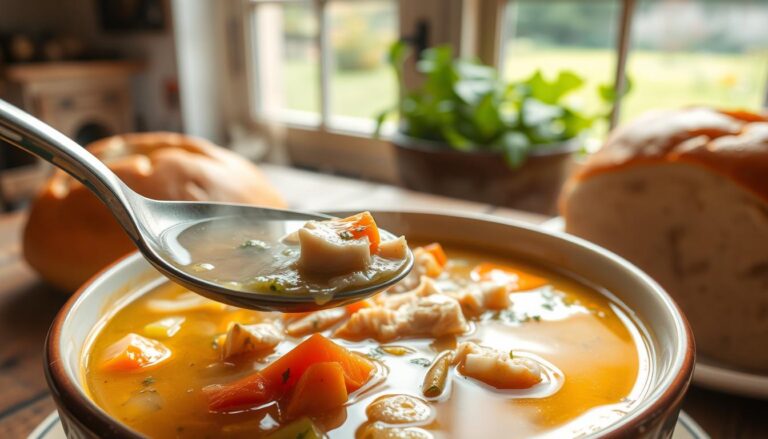How to Create Mouthwatering Salad Pizza at Home
Imagine a dish that brings together the savory flavors of a perfectly baked crust and the freshness of a garden salad. Salad pizza is a unique fusion that’s gaining popularity, and for good reason.
With the rise of health-conscious eating, people are looking for creative ways to enjoy their favorite foods without sacrificing nutrition. You can achieve this balance by making a delicious salad pizza at home.
By following a simple recipe, you can create a mouthwatering salad pizza that’s perfect for a quick dinner or a gathering with friends.
Table of Contents
What Makes Salad Pizza Special
Salad pizza is a mix of pizza’s taste and a salad’s health benefits. It’s a dish that’s tasty and good for you. This makes it a healthier choice than regular pizza.
The Origin of Salad Pizza
The idea of salad pizza started as a way to make pizza healthier. It adds fresh greens and veggies to the mix. This change came from the trend of eating healthier and trying new foods.
It’s a new take on Italian food, fitting today’s eating habits.
Health Benefits of Combining Salad and Pizza
Salad pizza is packed with nutrients and has fewer calories than regular pizza. The greens and veggies add fiber, vitamins, and antioxidants. Choosing whole-grain crust and healthy toppings makes it a fulfilling meal.
Plus, you can pick your favorite ingredients. This makes it great for those looking for a healthier pizza option without losing flavor.
Understanding Salad Pizza Fundamentals
A great salad pizza starts with its basic parts. To make a tasty salad pizza, you must know the different types and how to prepare them.
Different Types of Salad Pizza
Salad pizzas come in many forms, based on toppings and how they’re made. Some favorites include:
- Veggie-packed salad pizzas loaded with fresh veggies.
- Gourmet salad pizzas with unique toppings and flavors.
- Salad pizzas with protein like grilled chicken or shrimp.
These options let you try out different tastes and ingredients to find your favorite salad pizza.
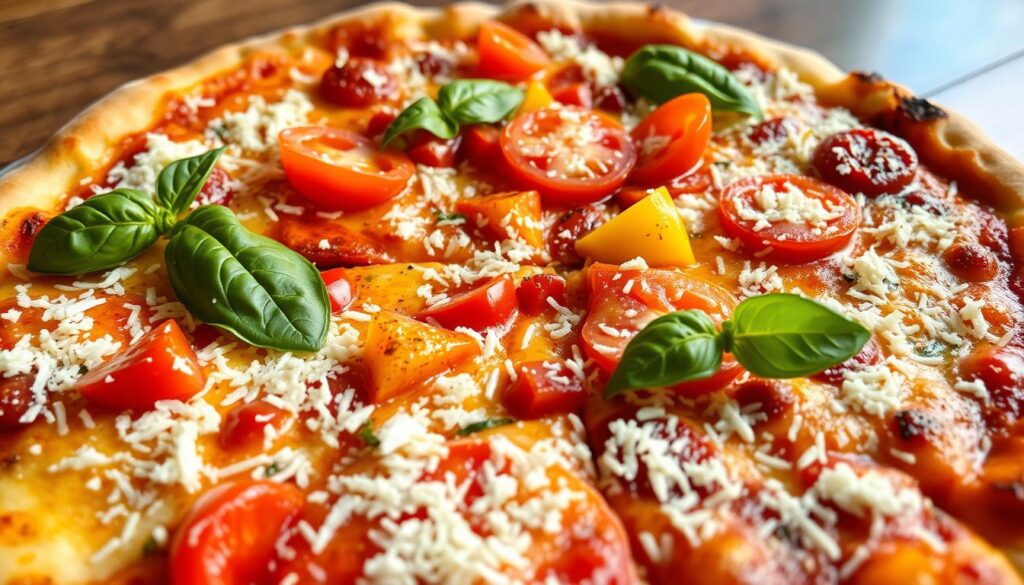
Hot vs. Cold Preparation Methods
The way you make your salad pizza affects its taste and feel. You can go for hot or cold preparation:
- Hot preparation means baking the pizza, which melts the cheese and crisps the crust.
- Cold preparation keeps the pizza uncooked, keeping the ingredients fresh.
Both ways have their benefits. Your choice depends on what you like and the ingredients you use.
Essential Ingredients for the Perfect Salad Pizza
Making the perfect salad pizza starts with picking the right ingredients. The quality of what you choose affects the taste and feel of your dish. You have many options to make your salad pizza tasty and fulfilling.
Pizza Base Options
The base of your salad pizza is key. You can go for traditional dough or try cauliflower crust or gluten-free. Each base has its own taste and texture, so pick one that fits your toppings well.
Fresh Greens and Vegetables
Fresh greens and veggies add crunch, flavor, and health benefits to your pizza. Use a mix of greens like arugula and spinach, and veggies like cherry tomatoes, bell peppers, and onions. It’s all about finding the right mix of tastes and textures.
Cheese Varieties
Cheese is essential for tying all the flavors together. You can pick from mozzarella, feta, and parmesan. Each cheese has its own taste and feel, so don’t be afraid to mix and match.
As “The key to a great salad pizza is using fresh, high-quality ingredients.” With the right base, greens, veggies, and cheese, you can make a salad pizza that’s both healthy and delicious.
Required Kitchen Tools and Equipment
Having the right kitchen tools is key to making a creative pizza that impresses. You’ll need a few basic items to prepare and cook your salad pizza.
Pizza Stones and Alternatives

A pizza stone helps get a crispy crust. If you don’t have one, you can use a baking sheet or cast-iron skillet.
- Pizza stone
- Baking sheet
- Cast-iron skillet
Helpful Utensils and Gadgets
You’ll also need various utensils and gadgets to prepare your salad pizza. A pizza peel, cutting board, and cheese grater are very helpful. These tools make it easier to put together and serve your unique pizza.
- Pizza peel
- Cutting board
- Cheese grater
Preparing the Perfect Pizza Dough
The foundation of a great salad pizza is its dough. You can make it from scratch or use alternative options. A well-crafted dough balances flavors and textures perfectly.
Traditional Pizza Dough Recipe
To make traditional pizza dough, start by mixing flour, yeast, water, salt, and olive oil. The quality of your ingredients matters a lot. Choose the best flour and fresh yeast you can find.
Kneading Techniques
Kneading is key for developing gluten in the dough. This makes the dough strong and elastic. You can use a stand mixer or knead by hand for 10 minutes, until it’s smooth and elastic.
Proofing Tips
Proofing lets yeast ferment, causing the dough to rise. Put the dough in a lightly oiled bowl, cover it, and let it rise in a warm, draft-free area. It should double in size.
Shaping Methods
After the dough rises, punch it down and shape it. You can make it round, oblong, or rectangular, depending on what you like.
Quick and Easy Alternatives
If making dough from scratch is too hard, there are quick and easy alternatives. These options can save time and still taste great.
Store-Bought Options
Store-bought pizza dough is a convenient choice. Look for brands that offer good flavor and texture.
Gluten-Free Variations
For those with gluten intolerance, gluten-free pizza dough is a good option. Keep in mind that gluten-free dough can be more delicate and may need different cooking times.
Cauliflower and Vegetable Crusts
Cauliflower and vegetable crusts are low-carb and gluten-free. They’re made by pulsing cauliflower or other vegetables in a food processor and mixing with cheese and eggs.
Creating the Ideal Pizza Sauce Base
The base of a great veggie pizza is its sauce. This sauce holds all the flavors and textures together. It’s key to a delicious salad pizza.
You can choose from many sauce bases, each with its own taste. Let’s look at some popular ones.
Classic Tomato Sauce
Tomato sauce is a classic choice for pizza. It’s made from crushed tomatoes, garlic, and herbs. It’s a timeless favorite that goes well with many toppings on your gourmet pizza.
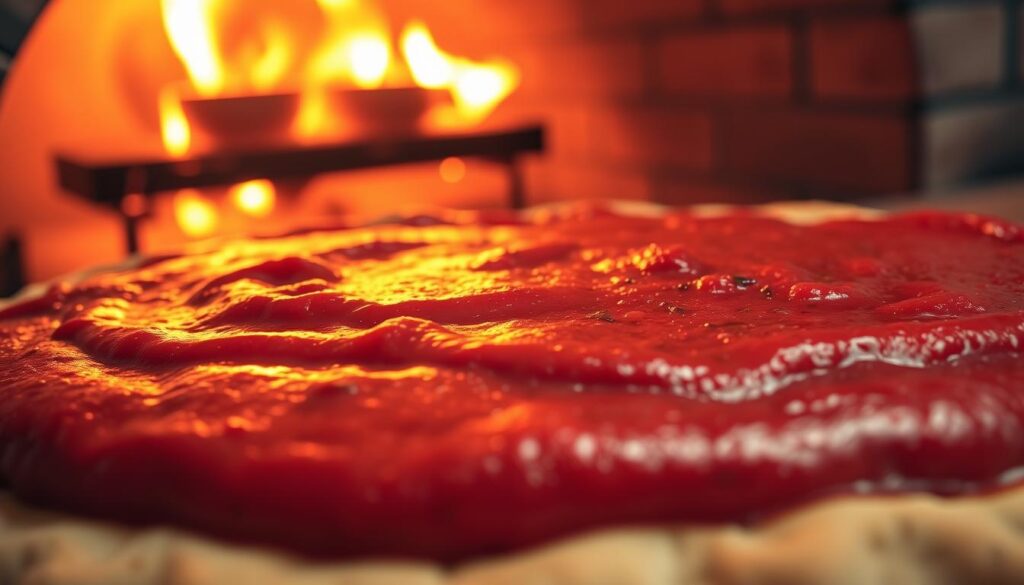
White Sauce Options
For a creamier option, try a white sauce. It’s made from ricotta, garlic, and olive oil. This sauce gives your salad pizza a rich and savory base.
Olive Oil and Herb Base
For a lighter choice, consider an olive oil and herb base. Mix olive oil with minced herbs like basil or oregano. This creates a flavorful yet subtle base for your veggie pizza.
Each sauce base brings a unique twist to the salad pizza. You can experiment to find the perfect match for your taste.
Pre-Cooking Techniques for Salad Pizza
Pre-cooking techniques can make your salad pizza better by adding more flavor and texture. By getting some parts ready before you put everything together, you can make a more exciting dish.
Preparing the Crust
A great fusion pizza starts with a good crust. To get it just right, bake the crust lightly in the oven. This makes sure it stays crispy even with all the toppings. You can also add olive oil or garlic butter for extra taste.
Pre-Cooking Certain Vegetables
Pre-cooking some veggies can make them sweeter and more flavorful. Roasting or grilling veggies like bell peppers, zucchini, or eggplant before adding them to your pizza can make them taste better. Just season them with your favorite herbs and spices first.
Using these pre-cooking methods can help you make a delicious pizza that everyone will love.
The Art of Assembling Your Salad Pizza
Assembling your salad pizza is where the magic happens. It turns simple ingredients into a culinary delight. The key is in the assembly, where fresh ingredients and tasty toppings come together in harmony.
Layering Techniques
The foundation of a great salad pizza is its layering. Start with a perfectly baked crust, then add a layer of your chosen sauce. Next, sprinkle a blend of cheeses that will melt and bind the flavors together.
Finish it off with a generous helping of fresh greens and your favorite vegetables. Each layer should complement the others, creating a balanced and satisfying flavor profile. Experiment with different combinations to find your perfect match.
Balancing Flavors and Textures
Balancing flavors and textures is crucial in creating a salad pizza that’s both delicious and visually appealing. Combine tasty toppings like roasted vegetables, savory meats, or tangy cheeses with a variety of textures, from crunchy to soft.
Don’t forget to add a drizzle of your favorite dressing to tie everything together. The right dressing can elevate the flavors and add a richness to your salad pizza.
Cooking Methods for the Perfect Salad Pizza
To make a creative pizza, knowing how to cook is key. The way you cook can change how your salad pizza tastes and feels.
Oven Baking Instructions
Oven baking is a classic way to cook salad pizza. First, heat your oven to 425°F (220°C) with a pizza stone inside, if you have one. Then, put your pizza on the stone or a baking sheet. Bake for 12-15 minutes, until the crust is golden and the toppings are hot.
Grill and Stovetop Alternatives
Try grilling or cooking on the stovetop for a unique pizza taste. Grilling gives a smoky flavor, while stovetop makes the crust crispy. To grill, heat your grill to medium-high and cook for 2-3 minutes on each side. For stovetop, use a skillet over medium heat and cook for 2-3 minutes on each side, until the crust is crispy and toppings are warm.
Cooking Times and Temperatures
Cooking times and temperatures depend on your method and crust thickness. A hotter oven or grill makes a crisper crust. A lower heat makes a softer base. Watch your pizza as it cooks to get the best flavors and textures.
Troubleshooting Common Salad Pizza Problems
The secret to a fantastic salad pizza isn’t just in what you put on it. It’s also about avoiding common mistakes. Knowing how to fix these issues can make your pizza a hit every time.
Preventing Soggy Crusts
A soggy crust can spoil an excellent salad pizza. To avoid this, bake your crust until it’s crispy. Also, don’t overload the pizza with toppings. Too much can make it soggy during cooking.
Fixing Overcooked or Undercooked Elements
If your healthy pizza has parts that are too cooked or not cooked enough, tweak your cooking time and temperature. Pre-cooking some veggies before adding them can also help with even cooking.
By using these tips, you can make a salad pizza that’s both healthy and tasty.
Dressings and Finishing Touches
Dressings and garnishes can make your salad pizza special. The right dressing brings together the flavors. A good garnish adds texture and makes your pizza look great.
Complementary Dressings
Choosing the right dressing is key. For a veggie pizza, a light vinaigrette is perfect. It highlights the sweetness of the veggies. But, a creamy dressing is better for pizzas with grilled chicken or rich toppings.
Popular dressings include balsamic vinaigrette, ranch, and Caesar. You can also make your own with olive oil, lemon juice, and herbs.
Herbs, Spices, and Final Garnishes
Adding herbs, spices, and garnishes can enhance your pizza. Sprinkle fresh herbs like basil or parsley on top. Red pepper flakes add a spicy touch. You can also use shaved parmesan, chopped nuts, or truffle oil.
By picking the right dressing and garnishes, your salad pizza becomes gourmet. Try different combinations to find your favorite.
Conclusion
You now know how to make a tasty and unique salad pizza at home. The secret is mixing fresh ingredients, creative ways to prepare, and a bit of trying new things.
Keep trying new flavors and ingredients as you make more salad pizzas. You can use traditional dough or cauliflower crust. Your pizza can become a hit, great for sharing with others or enjoying by yourself.
Making a fusion pizza is about finding the right mix and being creative. With practice, you can make a pizza that’s both delicious and special. So, start making your dream salad pizza today!



